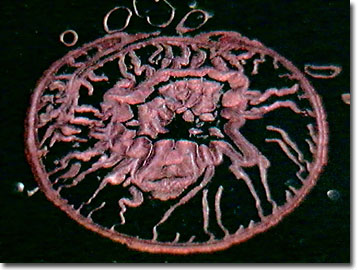Darkfield Digital Image Gallery
Metridium
A common genus of sea anemone, Metridium is found throughout the world's oceans. Usually white, but also tan, brown, or orange, the plumose anemone (M. senile) is often used as a dissection specimen in comparative anatomy classes and is found in the temperate seas of the Northern Hemisphere including the Atlantic and Pacific Coasts of North America and the coastal waters of Japan.

View a second image of a metridium.
View a third image of a metridium.
Known also as the frilled anemone, plumose anemones are often found attached to docks and pilings and look like gelatinous blobs when the tide is out. Underwater, they are quite photogenic as their tentacles open up like blossoming flowers. Adults in this anthozoan genus feed on small plankton that they capture with their stinging cells, or nematocysts. Nudibranchs and sea stars feed on M. senile and other Cnidaria species. Although sea anemones reproduce sexually, species in the genus Metridium are able to reproduce asexually as well, by breaking off pieces of their pedal disk (the body part that attaches to the substrate), and vegetatively growing a new clone, accounting for the alternative common name, clonal plumose sea anemone.
As the scientific species name implies, the white-plumed anemone (M. giganteum) is a very large cnidarian (or coelenterate) occurring in the giant kelp forest off the coast of Monterrey, California. Unlike most anemones, Metridium species prefer colder waters. As a group, the sea anemones are bottom dwelling, sedentary marine animals that can be found living in a variety of habitats. They occur from shallow tidal zones to depths of more than 30,000 feet (10,000 meters) and from tropical waters and deep-sea thermal vents to the Antarctic seabed. As one of the simplest animals by phylogeny and overall anatomy, it is ironic that the nematocysts that cover their tentacles are one of the most complex structures in the animal kingdom.
Contributing Authors
Cynthia D. Kelly, Thomas J. Fellers and Michael W. Davidson - National High Magnetic Field Laboratory, 1800 East Paul Dirac Dr., The Florida State University, Tallahassee, Florida, 32310.
BACK TO THE DARKFIELD IMAGE GALLERY
BACK TO THE DIGITAL IMAGE GALLERIES
Questions or comments? Send us an email.
© 1995-2025 by Michael W. Davidson and The Florida State University. All Rights Reserved. No images, graphics, software, scripts, or applets may be reproduced or used in any manner without permission from the copyright holders. Use of this website means you agree to all of the Legal Terms and Conditions set forth by the owners.
This website is maintained by our
Graphics & Web Programming Team
in collaboration with Optical Microscopy at the
National High Magnetic Field Laboratory.
Last Modification Friday, Nov 13, 2015 at 01:19 PM
Access Count Since September 17, 2002: 8813
Visit the website of our partner in introductory microscopy education:
|
|
